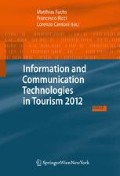Abstract
In this paper we discuss the exploitation of data originated from Bluetooth-enabled devices to understand visitor’s behaviour in the Louvre museum in Paris, France. The collected samples are analysed to examine frequent patterns in visitor’s behaviours, their trajectory, length of stay and some relationships, offering new details on behaviour than previously available. Our work reinforces the emergence of a new methodology to study visitors. It is part of recent lines of investigation that exploit the presence of pervasive data networks to complement more traditional methods in tourism studies, such as surveys based on observation or interviews. However, most past experiments have explored quantitative data coming from mobile phones, GPS, or even geo-tagged user generated content to understand behaviour in a region, or a city, at a larger scale than that of our current work.
Preview
Unable to display preview. Download preview PDF.
References
Agrawal, R. & Srikant, R. (1995). Mining sequential patterns. In ICDE’ 95: Proceedings of the Eleventh International Conference on Data Engineering. Washington DC: IEEE Computer Society.
Ahas, R., Aasa, A., Roose, A, Mark, U. & Silm, S. (2008). Evaluating passive mobile positioning data for tourism surveys: An Estonian case study. Tourism Management 29(3): 469–486.
Antonini, G., Bierlaire, M. & Weber, M. (2006). Discrete choice models of pedestrian walking behaviour. Transportation Research Part B Methodological 40(8): 667–687.
Asakura, Y. & Iryob, T. (2007). Analysis of tourist behaviour based on the tracking data collected using a mobile communication instrument. Transportation Research Part A: Policy and Practice 41(7): 684–690.
Barceló, J., Montero, L., Marqués, L. & Carmona, C. (2010). Travel Time Forecasting and Dynamic Origin-Destination Estimation for Freeways Based on Bluetooth Traffic Monitoring. Transportation Research Record. Journal of the Transportation Research Board 2175: 19–27.
Eagle, N. & Pentland, A. (2005) Reality mining: sensing complex social systems. Personal and Ubiquitous Computing 10(4): 255–268.
Giannotti, F., Nanni, M., Pedreschi, D. & Pinelli, F. (2007). Trajectory Pattern Mining. In Proceedings of the 13 th ACM SIGKDD international conference on knowledge discovery and data mining KDD 07, San Jose: 330–339.
Girardin, F., Calabrese, F., Dal Fiore, F., Ratti, C. & Blat, J. (2008). Digital footprinting: Uncovering tourists with user-generated content. Pervasive Computing, IEEE 7(4): 36–43.
Girardin, F., Dal Fiore, F., Ratti, C. & Blat, J. (2008). Leveraging explicitly disclosed location information to understand tourist dynamics: a case study. Journal of Location Based Services 2(1): 41–56.
Girardin, F., Dillenbourg, P. & Nova, N. (2009). Detecting air travel to survey passengers on a worldwide scale. Journal of Location Based Services 3(3): 210–226.
Hillier, B. & Tzortzi, K. (2006). Space Syntax: The Language of Museum Space. In S. MacDonald (Ed.), A Companion to Museum Studies. London: Blackwell Publishing.
Hooper-Greenhill, E. (2006). Studying visitors. In S. MacDonald (Ed.), A Companion to Museum Studies. London: Blackwell Publishing.
Kanda, T., Shiomi, M., Perrin, L., Nomura, T., Ishiguro, H. & Hagita, N. (2007). Analysis of people trajectories with ubiquitous sensors in a science museum. In Proceedings 2007 IEEE International Conference on Robotics and Automation (ICRA’07): 4846–4853.
Kostakos, V., O’Neill, E., Penn, A., Roussos, G. & Papadongonas, D. (2010). Brief encounters: sensing, modelling and visualizing urban mobility and copresence networks. ACM Transactions on Computer Human Interaction 17(1): 1–38.
Larson, J.S., Bradlow, E.T. & Fader, P.S. (2005). An exploratory look at supermarket shopping paths. International Journal of Research in Marketing 22: 395–414.
Nicolai, T., Yoneki, E., Behrens, N. & Kenn, H. (2006). Exploring social context with the Wireless Rope. In R. Meersman, Z. Tari and P. Herrero (Eds.), On the move to meaningful internet systems 2006: LNCS, vol 427. Heidelberg: Springer.
O’Neill, E., Kostakos, V., Kindberg, T., Fatah gen. Schieck, A., Penn, A., Stanton Fraser, D. & Jones, T. (2006). Instrumenting the city: Developing methods for observing and understanding the digital cityscape. In P. Dourish and A. Friday (Eds.), Ubicomp 2006, LNCS 4206: 315–332.
Paulos, E. & Goodman, E. (2004). The familiar stranger: anxiety, comfort, and play in public places In. Proceedings of the SIGCHI conference on Human factors in computing systems 6(1): 223–230.
Pereira, F. C., Vaccari, A., Giardin, F., Chiu, C. & Ratti, C. (2012) Crowdsensing in the web: analysing the citizen experience in the urban space. In M. Foth, L. Forlano, C. Satchell, and M. Gibbs (Eds.), From Social Butterfly to Engaged Citizen: Urban Informatics, Social Media, Ubiquitous Computing, and Mobile Technology to Support Citizen Engagement. Cambridge (MA): MIT Press.
Ratti, C., Pulselli, R., Williams, S. & Frenchman, D. (2006). Mobile Landscapes: using location data from cell phones for urban analysis. Environment and Planning B: Planning and Design 33(5): 727–748.
Sanfeliu, A., Llacer, M.R., Gramunt, M.D., Punsola, A. & Yoshimura, Y. (2010). Influence of the privacy issue in the Deployment and Design of Networking Robots in European Urban Areas. Advanced Robotics 24(13): 1873–1899.
Seyfried, A., Steffen, B., Klingsch, W. & Boltes, M. (2005). The fundamental diagram of pedestrian movement revisited. Journal of Statistical Mechanics: Theory and Experiment 2005(10): 10002–10002.
Yalowitz, S. S. & Bronnenkant, Kerry. (2009) Timing and Tracking: Unlocking Visitor Behavior. Visitor Studies 12(1): 47–64.
Author information
Authors and Affiliations
Editor information
Editors and Affiliations
Rights and permissions
Copyright information
© 2012 Springer-Verlag/Wien
About this paper
Cite this paper
Yoshimura, Y., Girardin, F., Carrascal, J.P., Ratti, C., Blat, J. (2012). New Tools for Studying Visitor Behaviours in Museums: A Case Study at the Louvre. In: Fuchs, M., Ricci, F., Cantoni, L. (eds) Information and Communication Technologies in Tourism 2012. Springer, Vienna. https://doi.org/10.1007/978-3-7091-1142-0_34
Download citation
DOI: https://doi.org/10.1007/978-3-7091-1142-0_34
Publisher Name: Springer, Vienna
Print ISBN: 978-3-7091-1141-3
Online ISBN: 978-3-7091-1142-0

